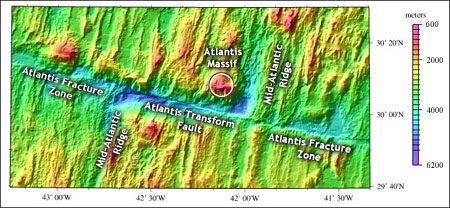Leaving port ...
Inching along, the crust created at ocean ridges moves away from both sides of the spreading center like a conveyor belt. Over millions of years, that crust continues aging. Since Earth is not growing in surface area, the net gain of material brought up from the mantle must be somehow balanced by an equal net loss somewhere else. Scientists think the old crust eventually gets recycled back to the mantle along various "subduction zones," where it is forced below a plate boundary within deep ocean trenches. As with the spreading centers where new crust is born, those crustal graveyards are areas of considerable earthquake activity, and frequent volcanic eruptions.
Ocean ridges rarely reach the surface, Iceland being the major example; they are usually remote places deep underwater. Still, researchers have managed to learn much about them through studies using sound waves, gravity detectors, deep ocean drilling, and personal observations aboard research submarines that can stand the crushing pressures of the ocean bottoms. One of many things they have deduced through this painstaking work is that lava does not ooze out continually or everywhere along a ridge. It instead emerges periodically along what is actually a set of zigs and zags rather then an unbroken line of volcanoes.

Fig. 1. Location of Atlantis Transform area.
Just southeast of the spot this expedition is targeting, for example, the Mid-Atlantic Ridge is abruptly bisected by a valley called the Atlantis Transform. This "transform fault" is one of many similar breaks that appear to reposition the ridge's path. In this case the ridge' north-south path is offset along the transform by about 75 kilometers (46.5 miles) to the west before resuming it's former southerly heading. Because both segments of the ridge are spreading apart and producing new crust, the transform between them is a zone of slip where crust grinds against crust, accompanied by periodic earthquakes.
Why should such ridges be broken by offsets? According to Cann, Tuzo Wilson of the University of Toronto offered an explanation that has since become a linchpin of plate tectonics. Wilson proposed that ocean ridges seem to run in zigs and zags because that was the jagged way the plates broke when they were originally formed as the supercontinent split.
Since that initial crack, the crustal conveyor belt operating on both sides of each ridge segment has left long scars of old transforms along ocean floors. These scars now extend over a major part of the Atlantic, for example. But, in a simple demonstration using a single ripped and folded piece of paper, Wilson showed how that movie could be played backwards to the starting jagged line, something geologists call "kinematics."
As R/V Atlantis steams just south of east towards its rendezvous with a mountain, an occasionally bumpy ride in moderate seas, expedition scientists are busy pouring over charts and computer files as well as assembling and testing the sensitive instruments they will use to probe the depths.
The beginning of the cruise is also a time to store up on sleep for the increasingly hectic days ahead, sign up for the ship's ping pong tournament to be held in the main laboratory, and hold mini-seminars in the ship's library. Soon after leaving Bermuda, they also donned life jackets for a fire and lifeboat drill.

|







